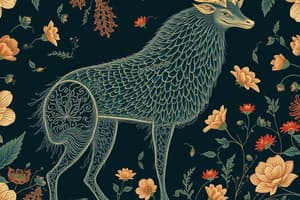Podcast
Questions and Answers
Match the following body structures with their characteristics:
Match the following body structures with their characteristics:
Radial symmetry = Body shape is similar around a central axis Bilateral symmetry = Body shape is similar on both sides of a central axis Coelom = A fluid-filled body cavity Acoelom = No body cavity
Match the following animal characteristics with their definitions:
Match the following animal characteristics with their definitions:
Herbivores = plant-eaters Carnivores = meat-eaters Omnivores = both plant- and meat-eaters Detritivores = decompose organic matter
Match the following types of animals with their characteristics:
Match the following types of animals with their characteristics:
Invertebrates = without backbone Vertebrates = with backbone Insects = have six legs Mollusks = have a soft, unsegmented body
Match the following animal behaviors with their definitions:
Match the following animal behaviors with their definitions:
Match the following animal characteristics with their examples:
Match the following animal characteristics with their examples:
Flashcards are hidden until you start studying
Study Notes
Classification of Animals
- Kingdom Animalia: Multicellular, eukaryotic, heterotrophic organisms
- Characteristics:
- Move voluntarily
- Respond to stimuli
- Obtain energy by consuming other organisms or organic matter
Types of Animals
- Invertebrates (without backbone): 95% of animal species
- Examples: insects, arachnids, crustaceans, mollusks, echinoderms
- Vertebrates (with backbone): 5% of animal species
- Examples: fish, amphibians, reptiles, birds, mammals
Body Structure
- Body Symmetry:
- Radial symmetry (e.g., starfish)
- Bilateral symmetry (e.g., humans)
- Body Cavities:
- Coelom (e.g., humans)
- Pseudocoelom (e.g., nematodes)
- Acoelom (e.g., flatworms)
Animal Characteristics
- Sensory Organs: eyes, ears, nose, tongue, skin
- Locomotion: walking, running, flying, swimming, crawling
- Feeding Habits:
- Herbivores (plant-eaters)
- Carnivores (meat-eaters)
- Omnivores (both plant- and meat-eaters)
- Detritivores (decompose organic matter)
Animal Behavior
- Instinct: innate behavior
- Learning: acquired behavior through experience
- Social Behavior:
- Solitary animals
- Social animals (e.g., packs, herds, colonies)
Classification of Animals
- Animals are multicellular, eukaryotic, and heterotrophic organisms.
- They move voluntarily, respond to stimuli, and obtain energy by consuming other organisms or organic matter.
Characteristics of Animals
- Animals have the ability to move voluntarily.
- They respond to stimuli, which means they react to changes in their environment.
- They obtain energy by consuming other organisms or organic matter.
Types of Animals
- Invertebrates make up 95% of animal species and do not have a backbone.
- Examples of invertebrates include insects, arachnids, crustaceans, mollusks, and echinoderms.
- Vertebrates make up 5% of animal species and have a backbone.
- Examples of vertebrates include fish, amphibians, reptiles, birds, and mammals.
Body Structure
- Radial symmetry is a type of body symmetry where body parts are arranged around a central axis, like a starfish.
- Bilateral symmetry is a type of body symmetry where body parts are arranged on both sides of a central axis, like humans.
- A coelom is a body cavity found in humans and some other animals.
- A pseudocoelom is a body cavity found in nematodes and some other animals.
- Acoelom is a body cavity found in flatworms and some other animals.
Sensory Organs and Locomotion
- Sensory organs include eyes, ears, nose, tongue, and skin.
- Locomotion refers to the ability to move and can be achieved through walking, running, flying, swimming, or crawling.
Feeding Habits
- Herbivores are animals that eat plants.
- Carnivores are animals that eat meat.
- Omnivores are animals that eat both plants and meat.
- Detritivores are animals that decompose organic matter.
Animal Behavior
- Instinct refers to innate behavior that is present from birth.
- Learning refers to acquired behavior through experience.
- Social behavior can be solitary or social, and social animals can live in packs, herds, colonies, or other groups.
Studying That Suits You
Use AI to generate personalized quizzes and flashcards to suit your learning preferences.




